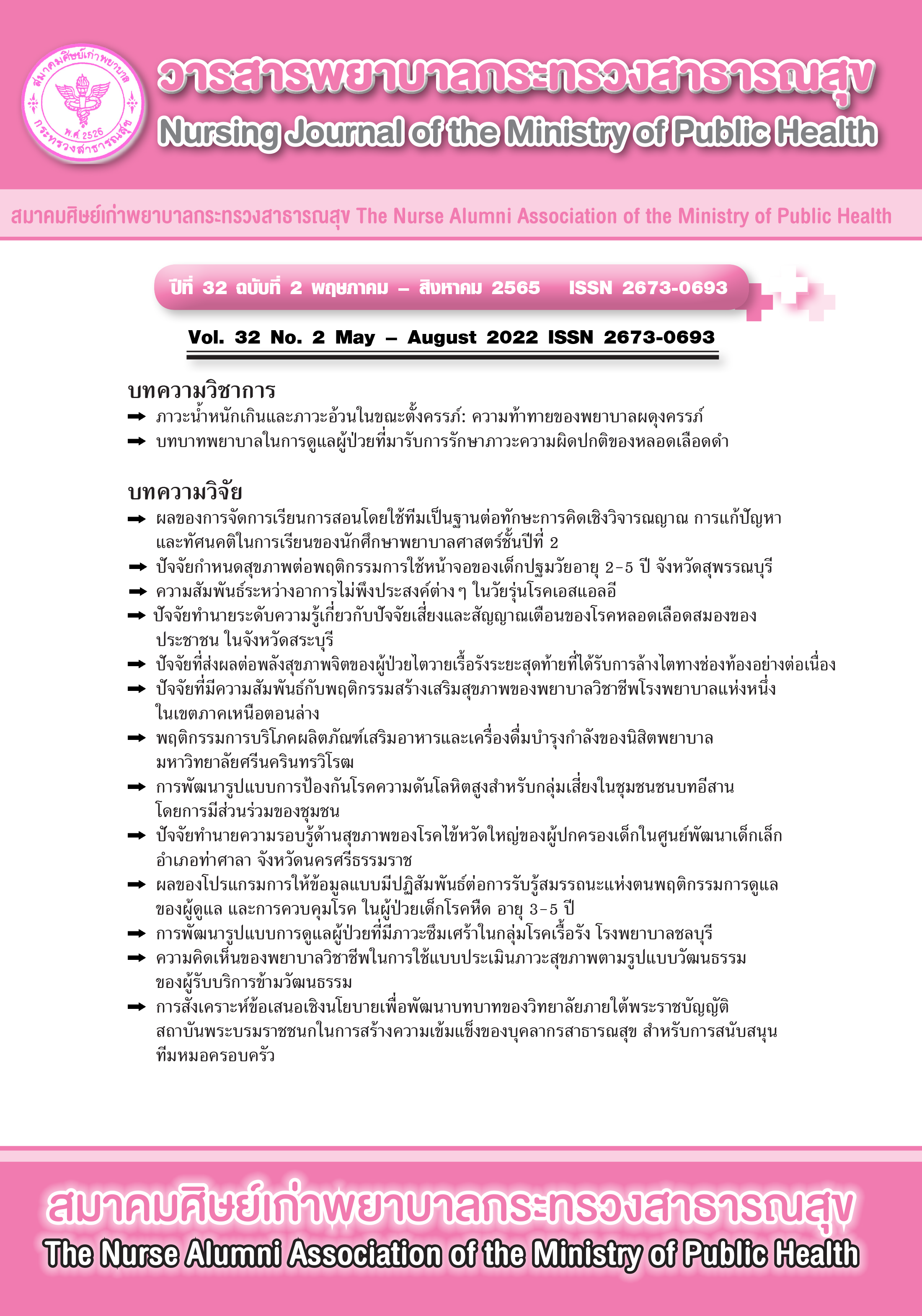Health Determinants of Screening-viewing Behaviors among Preschool Children Aged 2-5 Years in Suphanburi Province
Main Article Content
Abstract
This descriptive research aimed to study screening-viewing (SV) behaviors and the relationship between health determinants of parents, children, and family with SV behaviors among preschool children aged 2-5 years, Suphanburi province. The sample consisted of 303 parents of preschool children aged 2-5 years. Whereas, 182 parents returned the questionnaire (response rate = 60.06%). Data were collected by using self-administrated questionnaire. Then were analyzed by using descriptive statistics, chi-square statistics, and Spearman’s rank correlation coefficient. Results revealed that the demographic data among parents and their children were female (74.20%) with an average age was 36.60 years (SD=11.47) and 51.60% of the children were female with an average age was 42.23 months (SD=8.88), respectively. The screen type used by the children was television (79.70%). The family’s health was nuclear families (63.70%). SV behaviors among preschool children aged was moderate level (50.60%). The relationship between the determinants of health (parents, children, and family aspects) to such behaviors among preschool children aged 2-5 years, included the parental age (r=.280, p<.001), parental attitudes towards screen use. (r=.215, p=.002), perceptions of the effects of using the screen of children (r=.389, p<.001), parental SV behaviors (r=.190, p=.005), child growth (r=-.181, p=.012) and guardian (χ2=3.122, p = .047). The results suggest that parents should engage in developmental activities with their children to prevent the further adverse effects on children in the future.
Article Details

This work is licensed under a Creative Commons Attribution-NonCommercial-NoDerivatives 4.0 International License.
บทความและรายงานวิจัยในวารสารพยาบาลกระทรวงสาธารณสุข เป็นความคิดเห็นของ ผู้เขียน มิใช่ของคณะผู้จัดทำ และมิใช่ความรับผิดชอบของสมาคมศิษย์เก่าพยาบาลกระทรวงสาธารณสุข ซึ่งสามารถนำไปอ้างอิงได้
References
Alloway TP, Williams S, Jones B, Cochrane F. Exploring the impact of television watching on vocabulary skills in toddlers. Early Child Edu J 2014;42:343–9.
Lauricella AR, Wartella EA, Rideout VJ. Young children’s screen time: the complex role of parent and child factors. J Appl Dev Psychol 2015;36:11-7.
Lin LY, Cherng RJ, Chen YJ, Chen YJ, Yang HM. Effects of television exposure on developmental skills among young children. Infant Behav Dev. 2015;38:20-6. doi: 10.1016/j.infbeh.2014.12.005. Epub 2014 Dec 25. PMID:25544743.
Tancharoenwong AS, Pakdeeronachit S, Svetthitikun Y. Screen behaviour of Thai toddlers aged 0–3 years in Bangkok. The Journal of Social Communication Innovation 2018;6(2):60-9.(in Thai)
Ruangdaraganon N, Chuthapisith J, Mo-suwan L, Kriweradechachai S, Udomsubpayakul U,Choprapawon C. Television viewing in Thai infants and toddlers: impacts to language development and parental perceptions. BMC Pediatrics 2009;9:34doi:10.1186/1471-2431-9-34.
Chumprasert T, Wiroonpanich W, Wattanasit P. Relationships between the use of electronic media and the development of children aged 2-5 years in public child development centers in Songkhla province. The Southern College Network Journal of Nursing and Public Health 2019;6(2):91-104.(in Thai)
Ra CK, Cho J, Stone MD, De La Cerda J, Goldenson NI, Moroney E, Tung I, Lee SS, Leventhal AM. Association of digital media use with subsequent symptoms of Attention-Deficit/Hyperactivity Disorder among adolescents. JAMA 2018;17(3):255-63.
Tomopoulos S, Dreyer BP, Berkule S, Fierman AH, Brockmeyer C, Mendelsohn AL. Infant media exposure and toddler development. Arch Pediatr Adolesc Med 2010;164(12):1105-11.
Tupmalai K, The development model for promoting early child development at child care centers in Suphanburi province. Regional Health Promotion Center 9 Journal: The Journal for Health Promotion and Environment Health 2018;12(29):1-19.(in Thai)
Goh SN, et al. Sociodemographic, home environment and parental influences on total and device-specific screen viewing in children aged 2 years and below: an observational study.BMJ Open 2016;6:e009113. doi:10.1136/bmjopen-2015-009113.
Kaewanuchit C. Health determinants and social determinants of health under global and Thai health system. Journal of Nursing Science & Health 2013;36(1):123-31.(in Thai)
Krejcie RV, Morgan DW. Determining sample size for research activities. Edu Psychol Meas 1970;30 (3):607-10.
Fincham JF. Response rates and responsiveness for survey, standards, and the journal. Am J Pharm Educ 2008;72(2):1-3.
Best JW. Research in education. (3rded.). Englewood Cliffs, New Jersey: Prentice Hall, Inc; 1977.
Cohen J. Statistical power analysis for the behavioral sciences.(2nded.).Hillsdale, New Jersey: Lawrence Erlbaum Associates, Inc;1988.
Kosalpraphai A, Kiatrungrit K, Seree P. Association between parental internet use and behavioral problems in elementary students. J Psychiatr Assoc Thailand 2018;63(2):101-14.[in Thai]
Wongpipit W, Kritpet T, Phongphibool S. Physical activity and sedentary behavior: guidelines and assessment. Journal of Sports Science and Health 2020;21(1):1-21.(in Thai)
